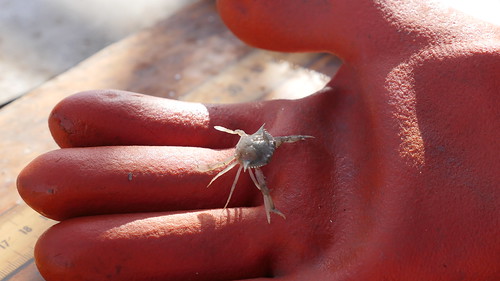
Photo caption – Staff examine a juvenile blue crab as part of the annual winter dredge survey; photo taken in 2017. Photo by Stephen Badger, Maryland Department of Natural Resources
Members point to lowest crab numbers in history of winter dredge survey, recent rapid rise in invasive blue catfish and snakeheads as cause for urgent action
On September 21, 2022., U.S. Senators Chris Van Hollen and Ben Cardin and Congressmen Steny H. Hoyer, Dutch Ruppersberger, John Sarbanes, Kweisi Mfume, Andy Harris, M.D., Anthony G. Brown, Jamie B. Raskin and David Trone (all Md.) urged U.S. Department of Commerce leadership to initiate a new benchmark stock assessment for the Chesapeake Bay blue crab population, in line with the recommendations of leading scientists and fisheries managers.
Following the lowest-ever blue crab population estimates in this year’s winter dredge survey, the Members of Congress called for expedient action to be undertaken using funding from the recently passed Inflation Reduction Act (IRA) or the Infrastructure Investment and Jobs Act (IIJA).
“The 2022 [winter dredge] survey demonstrates the complexity of the blue crab fishery. This year saw the Bay’s lowest number of crabs observed (227 million crabs) in the survey’s history. Approximately 97 million mature female crabs were estimated to be present in the Bay at the start of the 2022 crabbing season, which is above the abundance threshold of 72.5 million adult females, but well below the target of 196 million,” the Members of Congress write.
“While these results suggest that the blue crab population is not depleted relative to the reference points, worryingly, juvenile abundance has not responded to increases in female abundance as expected. Current, comprehensive information is needed to understand this disconnect, as well as to identify and address other factors attributed to the low overall population, including water quality, changes in weather patterns associated with climate change, habitat loss, and predation, including by invasive species such as blue catfish and northern snakehead.”
“Sound management of the species is vital to ensure the sustainability of this natural resource, which supports commercial, recreational, and subsistence fisheries,” the Members affirm. “We write to express our full support for a new benchmark stock assessment, as recommended in the Chesapeake Bay Stock Assessment Committee (CBSAC) 2022 Blue Crab Advisory Report.”
The Chesapeake Bay Stock Assessment Committee is an advisory group under the Chesapeake Bay Program’s Sustainable Fisheries Goal Implementation Team. The Maryland DNR, Virginia Marine Resource Commission, and the Potomac River Fisheries Commission each have a representative on this team to discuss fishery policies, including blue crab management.
This committee has met each year since 1997 to review the results of annual Chesapeake Bay blue crab surveys and develop management advice for the three jurisdictions, summarized in an annual report. The 2022 Blue Crab Advisory Report released in July included a new recommendation to update the 2011 benchmark stock assessment.


